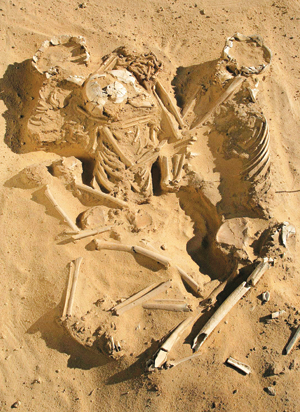Remains of a greener day
By Lydialyle Gibson
Photo by Mike Hettwer, courtesy Project Exploration
In the western Sahara’s once-verdant expanse, Chicago paleontologist Paul Sereno studies the fossil remains of cow-like Nigersauruses, bus-sized SuperCrocs, and the scaly scavenger Rugops primus. In recent years he’s also been studying the bones of another species: his own. Sereno’s foray into archaeology began in 2000, when his dinosaur-hunting expedition ran across a Stone Age graveyard in Niger’s Ténéré Desert—the largest ever found in the Sahara. Sticking up from the sand, dozens of skeletons lay just as they were buried: a girl with a hippo-tusk bracelet encircling her upper arm, a man seated on a mud-turtle shell, a woman and two children interred on a bed of flowers, their arms outstretched in an embrace (below). Harpoon points, beads, stone tools, pottery fragments, and other artifacts also dotted the surface of the dune field known as Gobero.

Two seasons of excavation yielded more than 200 graves, belonging to two distinct cultures at what had been an ancient lakeside fishing and hunting settlement back when the Sahara was fecund and green. The oldest inhabitants, the Kiffians, lived during Gobero’s -wettest period, between 10,000 and 8,000 years ago. Standing six feet tall, they hunted wild game and harpooned large perch until a millennium-long drought drove them away. When the rains returned, the Tenereans, a more lightly built people, settled in, fishing, hunting, and herding cattle until the area dried up for good 4,500 years ago. It was the Tenereans who gave their dead such singular burials. In the triple grave holding the woman and five- and eight-year-old children—presumably hers—arms and legs and fingers were carefully positioned to interlace and overlap.
“These are things that we’ve never seen before from the fossil record,” noted Sereno, whose international team of scientists, archaeologists, and anthropologists documented its findings in the August 14 PLoS One and the September National Geographic. “They represent some of the most dear customs to people that we’re just beginning to get to know.”
